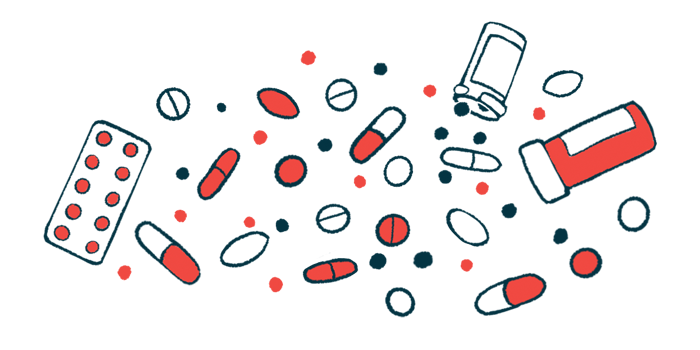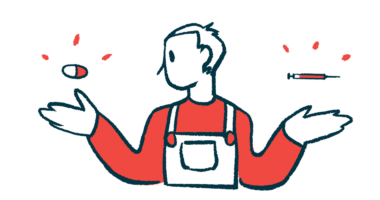Voydeya as add-on treatment is safe, effective in PNH
Therapy and C5 inhibitor reduced extravascular hemolysis in ALPHA study

Voydeya (danicopan) effectively and safely treated paroxysmal nocturnal hemoglobinuria (PNH) in people with significant extravascular hemolysis, when used as an add-on therapy to Ultomiris (ravulizumab) or Soliris (eculizumab).
That’s according to long-term data from the Phase 3 ALPHA trial (NCT04469465), which found that dual treatment with Voydeya and a C5 inhibitor could reduce extravascular hemolysis, while keeping intravascular hemolysis under control. The benefits were maintained for up to 72 weeks, or nearly 1.5 years. Extravascular hemolysis is when red blood cells break down outside the blood vessels. Intravascular hemolysis occurs with the breakdown of red blood cells inside blood vessels.
“These findings represent the first long-term data from a Phase 3 trial demonstrating the efficacy of … [Voydeya] in combination with [Ultomiris] or [Soliris] for addressing [intravascular] and [clinically significant extravascular hemolysis] while maintaining control of terminal complement activity in PNH,” the researchers wrote.
The findings were detailed in the study, “Long-Term Efficacy and Safety of Danicopan as Add-On Therapy to Ravulizumab or Eculizumab in PNH With Significant EVH,” published in Blood.
PNH is a rare disease marked by hemolysis, which causes anemia, or low red blood cell counts, as well as other symptoms like fatigue.
Blood cells in PNH patients lack two important proteins that act as identification badges, signaling to the immune system that the cells are healthy parts of the body. Without the proteins, red blood cells are susceptible to being attacked and destroyed by the complement system, a component of the immune system.
Soliris and Ultomiris are complement inhibitors that target a complement protein C5 to block complement activation. While the therapies are usually effective at stopping intravascular hemolysis, they’re not as good at preventing extravascular hemolysis, which, when persistent, can lead to substantial disease symptoms in about 10% to 20% of PNH patients taking Soliris or Ultomiris.
Patients treated with C5 inhibitors alone may also have breakthrough intravascular hemolysis, a temporary, but sometimes severe, reappearance of symptoms and a return of intravascular hemolysis, which can occur due to suboptimal C5 inhibition and/or complement-amplifying conditions, like pregnancy or infections, that lead to increased complement activation.
What is Voydeya?
Voydeya is an add-on therapy intended for use alongside C5 inhibitors. It works by targeting factor D, a different complement protein. By targeting factor D, Voydeya prevents C3, another protein in the complement cascade that plays a pivotal role in extravascular hemolysis, from activating. Doing this should help prevent extravascular hemolysis.
Voydeya has been approved as an add-on therapy to C5 inhibitors to help control extravascular hemolysis in PNH patients in the U.S., European Union, and other regions. Its approvals were based on data from the ALPHA trial, which tested it in 86 adults with PNH with clinically significant extravascular hemolysis.
In the trial, participants received Voydeya three times a day along with Soliris or Ultomiris for 12 weeks, or about three months. After that, they were able to enter an open-label period where they received Voydeya for 12 more weeks, followed by a long-term extension phase to continue the dual treatment for up to two years.
Previous data from ALPHA showed dual treatment with Voydeya and a C5 inhibitor was safe and more effective than a placebo at raising hemoglobin, the protein that carries oxygen in red blood cells, to near normal levels when taken for up to 48 weeks, or nearly a year.
Safety, efficacy in ALPHA study
Here, researchers presented long-term efficacy and safety data from ALPHA, including its open-label period and long-term extension phase, with 71 trial participants having more than 72 weeks of exposure to Voydeya.
The levels of lactate dehydrogenase in the blood, a marker of intravascular hemoloysis, were well controlled in patients treated with Voydeya. The management of intravascular hemolysis was maintained for 72 weeks.
Researchers found that at week 72, 53.7% of patients who were on Voydeya for the entire study had a clinically meaningful increase in hemoglobin levels (2 g/dL or more) in the absence of a blood transfusion. The same was observed in 46.2% of those initially assigned to a placebo who switched to Voydeya.
Overall, 64.3% of the patients treated with Voydeya didn’t need a blood transfusion throughout the study. At week 72, 80% of those who remained on Voydeya during all phases of the study avoided a blood transfusion, as did 79.2% who switched from a placebo. The number of transfused red blood cell units also decreased after starting Voydeya.
Dual treatment with Voydeya and a C5 inhibitor also eased fatigue, with patients treated with Voydeya having fatigue levels comparable to those in the general population.
Long-term data showed Voydeya was a safe add-on to C5 inhibitor therapy. No treatment-related serious adverse events were reported in the long-term extension. Breakthrough hemolysis was reported in five patients, but not one event was deemed related to Voydeya.
All these episodes resolved “resolved rapidly without trial discontinuation, dose adjustment, or need for transfusion,” the researchers wrote. “Results reported herein confirm those of the primary efficacy analysis [of the ALPHA trial] and show that these improvements are maintained long term in a larger cohort … highlighting the ability of [Voydeya] to address hematologic abnormalities associated with severe [clinically significant extravascular hemolysis].”








